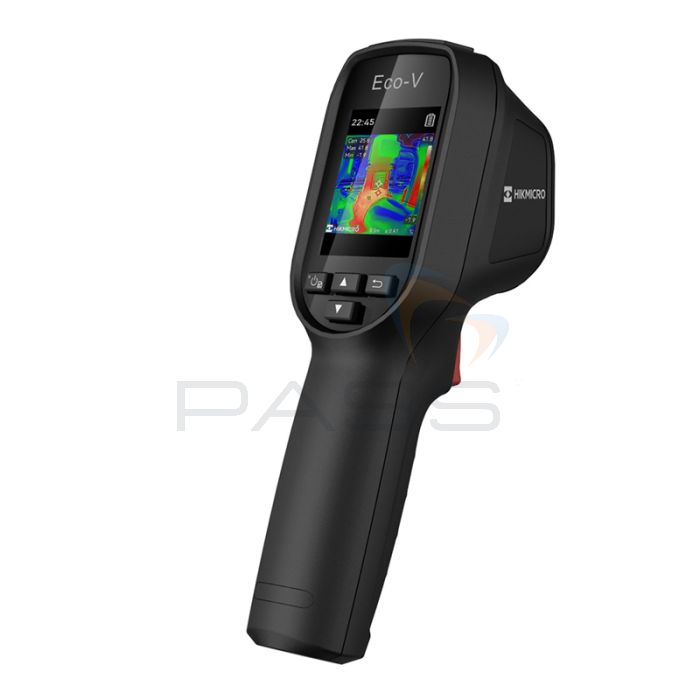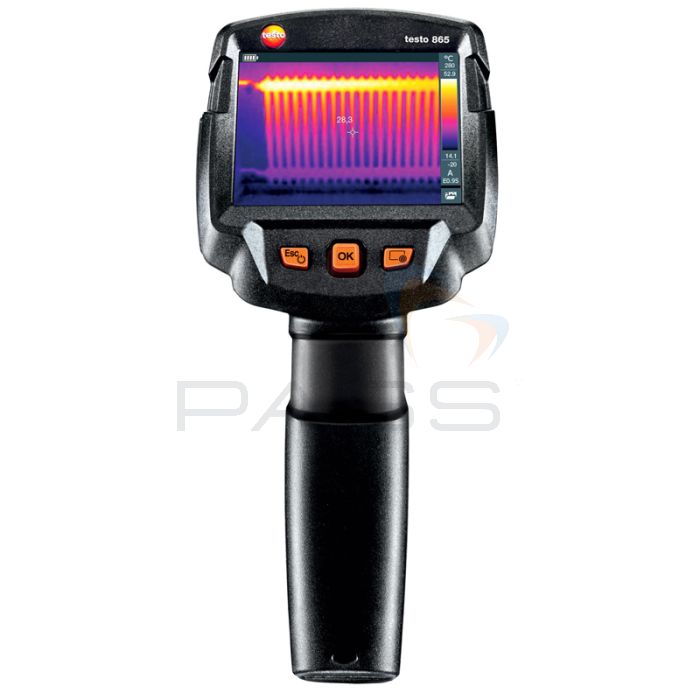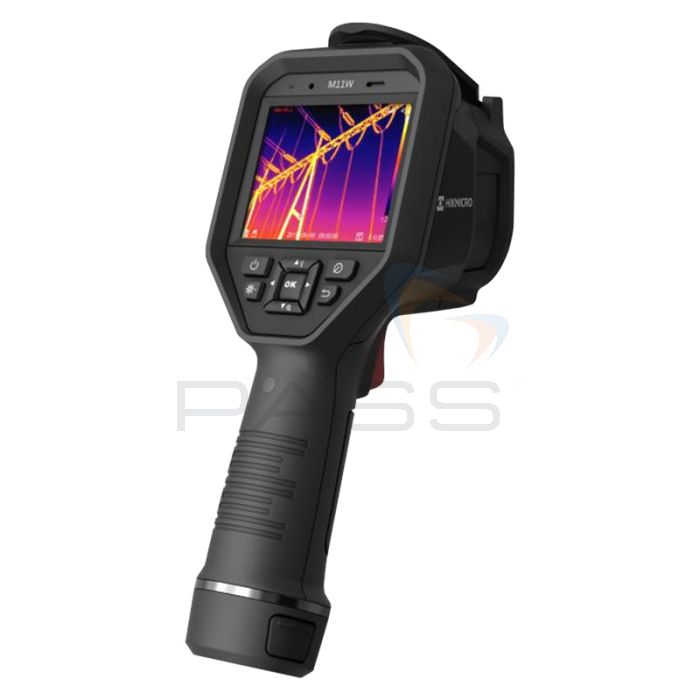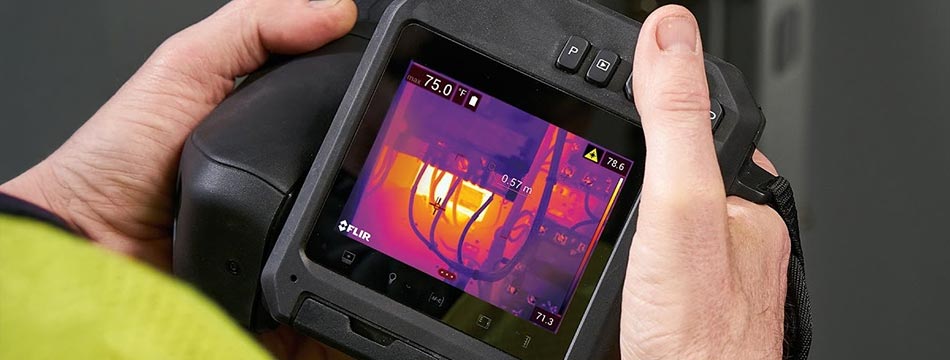
Everyone wants to know, “what’s the best thermal camera?” However, the truth is that there is no one “best” thermal camera because the best thermal camera is the one that meets your needs, application, preferences, and budget the best. Choosing a thermal imaging camera is less about choosing the “best” one and more about choosing the right model for you. Yet, here we run into another problem: how do you choose the right thermal camera? Fear not, because this buying guide highlights the key specifications and features to consider when choosing a thermal camera.[1]
So, if you want more than an Android or iPhone thermal camera, and are wondering which thermal camera to buy, read this!
Quick Links
- Why do you need a thermal imaging camera?
- How much do you want to spend on a thermal camera?
- Do you have a preferred thermal camera brand?
- What thermal camera resolution do you need?
- Do you need high or low thermal sensitivity?
- What are the min & max temperatures you need to measure?
- Which focus type is right for your application?
- Do you need a narrow or wide field of view lens?
- Which reporting & analysis features do you need?
- What is your preferred thermal camera design?
- What kind of battery life do you require?
- Do you need any additional features?
- Popular Thermal Cameras
- Further Information
1. Why do you need a thermal imaging camera?
In other words, what do you need your thermal camera for? When considering thermal cameras, always keep your application in mind. Knowing what your thermal camera must be capable of will enable you to assess specifications accordingly.
Your application will depend on your profession and tasks; for instance, electricians may need a thermal imaging camera for spotting overheating components but do not require the sophisticated analysis features that are essential to R&D professionals. Similarly, ecologists might be able to do without the precise temperature measurements that veterinaries need, instead, they may require a wide-angle lens and broad field-of-view for surveying vast areas of wildlife.
Shop thermal cameras by application:
- Electrical Inspection
- Building & Energy Surveying (Internal)
- Building & Energy Surveying (External)
- Plumbing & HVAC/R Inspection
- Industrial Condition Monitoring
- Ecology & Veterinary
- Solar & Renewables
- Oil & Gas
- Furnace & High Temperature
- Educational
Additional applications (not covered in this guide):
At PASS/ tester.co.uk, we offer an array of thermal cameras with a comprehensive selection of abilities at a variety of price points.
2. How much do you want to spend on a thermal camera?
We appreciate that budgets vary. That’s why we are proud to offer a range of superb thermal imagers by leading brands at a range of price points, ensuring you do not have to compromise functionality or quality to accommodate your funds.
Shop thermal imaging cameras by price:
- Best Thermal Cameras Under £500
- Best Thermal Cameras £500 - £1000
- Best Thermal Cameras £1000 - £5000
- Best Thermal Cameras Over £5000
Like application, it is important to keep your budget front of mind when comparing thermal cameras.
3. Do you have a preferred thermal camera brand?
As mentioned, we stock thermal cameras by leading brands such as FLIR, Fluke, Hikmicro, Seek Thermal, and Testo. All brands have their merits, however, if you favour a particular manufacturer, this can be an effective way of narrowing down your options.
4. What thermal camera resolution do you need?
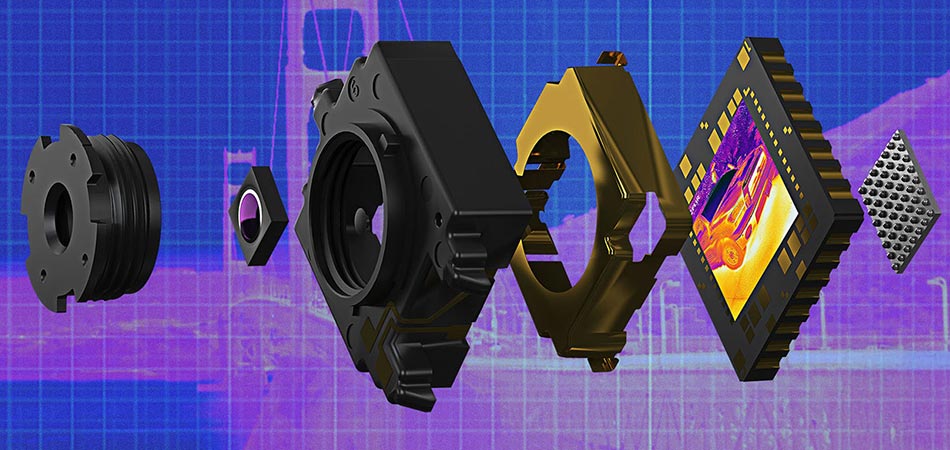
Thermal/IR or detector resolution pertains to the number of pixels contained within a thermal image. For instance, a thermal camera with a 160 x 120px IR resolution will capture thermal images composed of 19,200 pixels, whereas a thermal camera with a 640 x 480px detector will deliver images with 307,200 pixels.
The greater the number of thermal pixels, the sharper the image and the more dependable and accurate the heat representation. Cameras with higher thermal resolutions are also capable of detecting smaller targets from further away. Moreover, radiometric cameras (which offer a temperature reading for each pixel) with higher resolutions will provide significantly more data, ensuring precise and reliable measurements.
It is important to note that thermal resolution is distinct from display resolution. As such, when it comes to picking a thermal imager that is going to deliver the thermal detail and detection you need, it is thermal resolution that counts.
High resolution
Consequently, if you plan on doing any combination of the following, you should invest in a thermal camera with the highest IR resolution your budget allows:
- Detecting small targets at long distances
- Capturing thermal images with detailed heat distribution
- Collecting thermal images that contain comprehensive, multi-point temperature measurements
Low resolution
As you may have guessed, the greater the IR resolution, the more expensive the thermal camera. That’s why, if you don’t need a thermal camera that can do all the above, it might be worth investing in a model with a lower thermal resolution.
Thermal cameras with a smaller IR resolution may be unable to detect tiny objects at great distances or provide comprehensive heat maps with thousands of temperature readings; nevertheless, they are perfect for close-range applications and examining easily accessible targets. For those who require an easy-to-use, efficient tool for pinpointing potential problems within a few meters, a thermal camera with a low resolution is likely the perfect option for you.
Thermal Cameras with IR Resolutions Under 240 x 180pxMid resolution
Still, many professionals may need more clarity and data than a low-resolution thermal imaging camera allows but do not have the funds for a high-resolution IR imager. This is easily rectified. Professionals in this position have two options.
The first option is to invest in a low-resolution thermal camera equipped with resolution-enhancing technology. Cameras with this function combine a series of images of the same scene to increase the number of pixels in an image, thereby improving the thermal resolution.
Alternatively, many leading brands offer mid-resolution thermal cameras. With this second option, professionals can gather sharper, more detailed images than would be possible with low-resolution models, even if these models do not offer the same detection range, degree of detail, or quantity of temperature measurements as their high-resolution counterparts. Instead, mid-range models provide significant economic savings (compared to similar high-res models).
Mid-Resolution Thermal Cameras5. Do you need high or low thermal sensitivity?
You may be thinking, “What sort of question is this? Of course, I need high thermal sensitivity.” Nonetheless, it is worth stopping to think about this as, once again, the higher the sensitivity, the greater the expense.
Thermal sensitivity relates to the smallest temperature difference that the camera can detect and depict. It is often listed in specifications as NETD (Noise Equivalent Temperature Difference) and is measured in milliKelvins (mK). The important thing to know is: the smaller the NETD value, the better the thermal sensitivity. For example, a thermal camera with a 20mK NETD can detect smaller temperature differences than an imager with a 50mK NETD. This means that if these two cameras have the same IR resolution, the model with a 20mK will produce a sharper, crisper image because it can capture subtler changes in temperature.
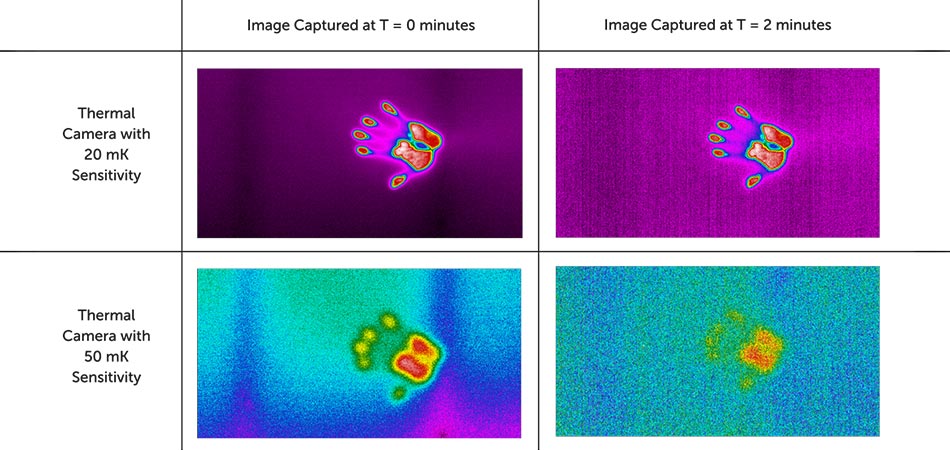
High sensitivity (Low NETD)
Better thermal sensitivity offers advantages such as clearer, sharper images capable of illustrating thermal contrast even in environments where thermal difference is slight. Consequently, investing in a thermal camera with a high thermal sensitivity (that’s a low NETD) is a must for anybody working in areas or conditions where there’s likely to be low thermal contrast, for instance, in environments with fog, smoke, and dust. Similarly, professionals searching for subtle temperature differences that may indicate a problem, such as moisture intrusion, should invest in a high-sensitivity thermal camera.
High-Sensitivity (Low NETD) Thermal CamerasLow sensitivity (High NETD)
However, if you work in environments that typically have a big thermal contrast, or if you tend to inspect equipment, areas, or components with wide temperature differences, then you may not need a thermal camera with a high thermal sensitivity. As you are not looking to capture slight temperature differences, a model with a higher NETD value and, therefore, lower thermal sensitivity (and typically lower price) may be the right thermal camera for your needs.
Low-Sensitivity (High NETD) Thermal Cameras6. What are the min & max temperatures you need to measure?
All thermal cameras measure temperature; however, the range of temperatures that models can detect, measure, and depict varies between IR imagers. When choosing the right thermal camera, consider the highest and lowest temperatures you will need to detect. It is advisable to select a model that comfortably accommodates these within its measurement range. For instance, if the lowest temperature you need to measure is 0°C and the highest is 550°C, then a thermal imaging camera with the range -20°C to +650°C is a good choice.
Shop thermal cameras by temperature range:
- Minimum Temperatures Below -21°C
- Minimum Temperatures Above -20°C
- Maximum Temperatures Below +650°C
- Maximum Temperatures Above +651°C
Do you need radiometric thermal imaging?
Some professionals only need to view the heat distribution of an area; therefore, a general assessment of the hottest and coldest temperatures within the scene is sufficient. However, if you need to determine the precise temperatures of points within a location, a radiometric thermal imager, which provides an accurate temperature reading for each pixel, is a must.
7. Which focus type is right for your application?
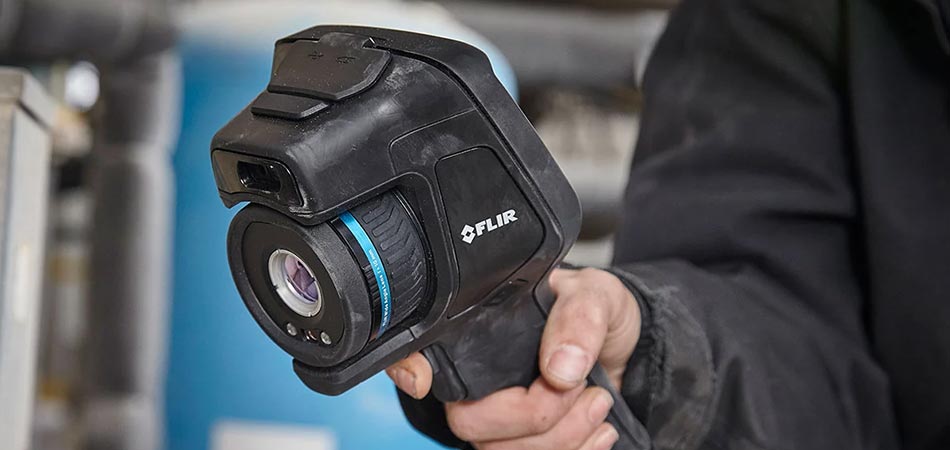
Thermal cameras are available with an array of focus types, ranging from fixed to manual to automatic and laser-assisted. Some even offer multiple focuses. When choosing the right thermal camera, you must select a model with a focus or focuses that meet the demands of your application.
Most entry model thermal cameras offer a fixed focus, which means the user must move the camera to capture crisp images. These cameras are perfect for those who want to do a quick inspection and do not need professional images for reporting or precise temperature measurements.
It is important to realise that out-of-focus images compromise the accuracy of temperature measurements. Therefore, if you do require accurate measurements or crisp images for reports, you may be better off investing slightly more into a thermal camera that offers manual and/or auto focus:
- Manual focus: provides the freedom to adjust the focus in precise increments
- Auto focus: the camera automatically focuses on the target; though users may need to fine-tune the focus, automatic focus removes much of this time-consuming work
- Laser-assisted focus: uses a laser to pinpoint the target and calculate the distance to it
8. Do you need a narrow or wide field of view lens?
Another way to think about this is, what size or type of lens do you require? E.g., standard, wide angle, telephoto, or macro. Bear in mind that the wider the field of view, the shorter the focal length (generally); as such, while you may be able to see more of the scene, objects that are far away will remain far away. Conversely, a narrow field-of-view will limit the scope of the scene, but objects that are at a significant distance will be rendered in great clarity, effectively “bringing them closer” to you.
Considering this, if your work involves a lot of close-up inspections, a wide-angle lens of 45° or greater may be ideal. However, if you anticipate inspecting objects, especially small objects, from a great distance, a telephoto lens (e.g., 6° or 12°) offering a narrow field-of-view but a long focal length is preferable.

If you require both close-up and long-range capabilities and/or need to switch between wide and narrow fields of view, thermal imagers that support use with interchangeable lenses could be your best option. These cameras tend to be more expensive; however, they do provide greater versatility as they can be tailored to the application while you’re working in the field.
9. Which reporting & analysis features do you need?
First, ask yourself: do you need to create professional reports and/or analyse thermal images?
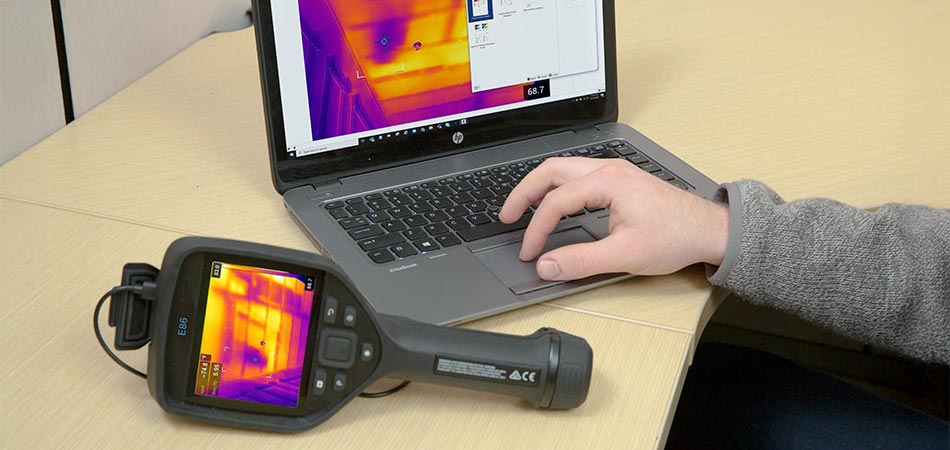
Basic Reporting
Most thermal cameras come with a basic level of image analysis and reporting, whether this is installed on the imager itself or accessed via an affiliated app or desktop software. If simple image/data analysis and/or reporting will meet the needs of your business, then you could save by choosing a thermal camera with basic analysis and reporting functions.
Thermal Cameras with Basic ReportingProfessional Reporting
Still, some businesses or industries will need to thoroughly analyse data and images as well as compile comprehensive professional reports either to meet company expectations or ensure compliance with regulations. In this instance, investing more money into a thermal imaging camera with a comprehensive suite of analysis and reporting options (accessible either via the unit, app, or desktop software) will prove beneficial and cost-effective in the long term.
Thermal Cameras with Professional ReportingImaging & Analysis Functions
Most thermal cameras are equipped with a selection of imaging and analysis functions. Consider which features are going to improve the ease, efficiency, and precision of your job and ensure your chosen thermal camera supports these capabilities.
- Thermal Colour Palettes: selectable colour palettes allow you to enhance certain thermal contrasts, tailoring the camera to your application and/or environment
- Spots and Markers: with these tools, you can simultaneously compare temperatures at multiple points in an image
- High and Low Temperature Alarms: user-customisable high and low temperature alarms will automatically alert you to any temperatures that exceed your pre-defined limits
Memory
Depending on the volume and type of reporting (basic or professional), you may need to assess the memory size of your chosen thermal camera. Most handheld thermal cameras include some memory capacity; although thermal modules, which connect to a smartphone or tablet, tend not to have a built-in memory, rather they leverage the connected device’s storage and/or rely on Cloud space. If you need to produce comprehensive, image-heavy reports and/or large quantities of reports, investing in a thermal camera with a sizeable memory to store multiple images and videos will prove useful. Often, these images can be downloaded to a PC/laptop via a USB, Bluetooth or Wi-Fi interface.
Wi-Fi & Bluetooth
In addition to this, selected thermal cameras with Wi-Fi and/or Bluetooth can connect to dedicated brand-specific thermal imaging apps, enabling on-site image analysis and report generation. Reporting is often basic; however, thermal cameras with this capability significantly improve job efficiency.
Moreover, brands such as Fluke and FLIR have built this same app-connectivity into their test and measurement equipment. In building an ecosystem of tools around a dedicated app, such as Fluke Connect or FLIR METERLiNK, these brands streamline data collation and report creation. If you anticipate combining thermal images with measurement data, investing in a Wi-Fi- or Bluetooth-enabled thermal camera with this kind of app connectivity may prove useful.
10. What is your preferred thermal camera design?
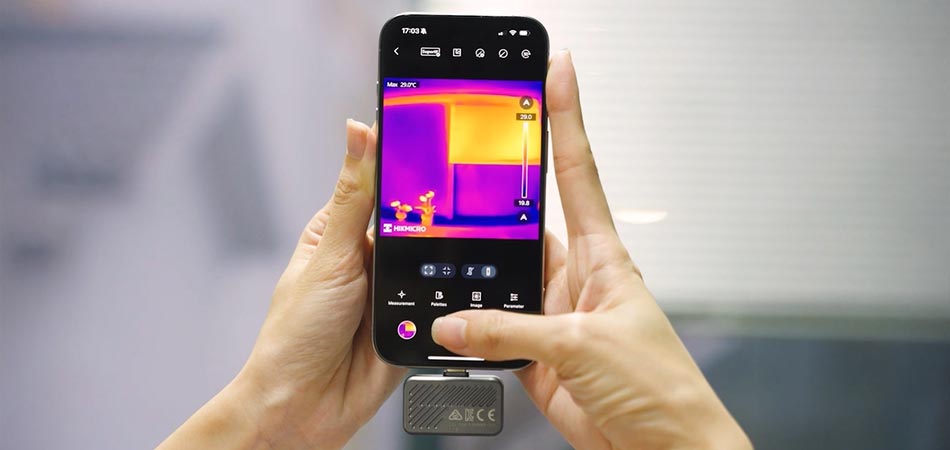
Depending on how you answered the preceding questions, you may have already excluded some thermal camera designs; for instance, Android/iPhone attachments are not available with IR resolutions of 640 x 480px or above.
- Pocket or Smartphone: If you are looking for a portable low- to mid-resolution thermal camera with basic analytical and reporting functions, perhaps consider a pocket-sized thermal camera or Android or iPhone thermal attachment.
- Pistol Grip: Low-resolution thermal cameras, as well as mid- and high-resolution imagers, are also available in pistol-grip designs. These cameras are perfect for one-handed operation and are ideal for indoor surveys, although they can be used outside.
- Rotating Lens Block: The final design option is a handheld unit with a rotating lens and/or screen. Thermal cameras with this design tend to offer mid- to high-resolutions. These cameras are intended for two-handed operation and are perfect for long and/or outdoor inspections. A rotating lens enables users to remain in a comfortable position while viewing awkward-to-access targets. Similarly, an adjustable screen means the display can be tilted to provide excellent readability even in challenging weather conditions, such as bright sunlight.
11. What kind of battery life do you require?
Again, the type of battery and length of operating time will depend on your application and industry. For instance, if you’ll be using your thermal camera continually every day, it’s best to invest in an IR imager with a long battery life that supports quick, easy swapping of batteries. However, if you’ll only be using your thermal imaging camera in short bursts every few weeks, you may prefer an IR imager with a long battery standby period.
In light of this, when comparing thermal imagers, always pay attention to:
- Expected battery life based on continuous use
- Battery standby time
- Interchangeability of batteries
12. Do you need additional features?
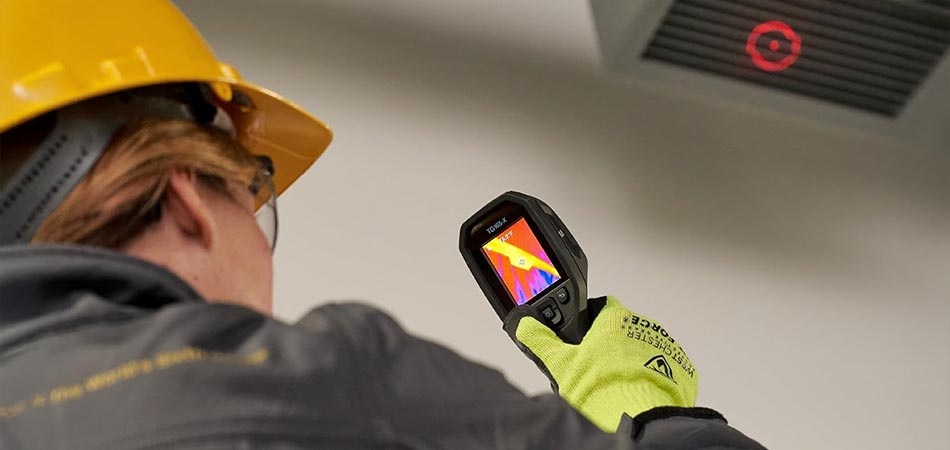
Thermal cameras are often available with a range of additional features intended to make inspections and diagnostics quicker, easier, and more convenient. When choosing the right thermal camera for your needs, consider whether you would benefit from any of the following.
Visual Camera
Many (though not all) thermal cameras feature a built-in visual camera, enabling you to capture digital photographs as well as thermal images. Moreover, models with a built-in visual camera often support image overlay. This makes pinpointing faults precise, efficient, and simple because digital details are combined with the thermal picture.
Please note that image overlay functions are termed differently depending on the thermal camera brand. The following functions all combine digital details with thermal images to render a sharper image:
- FLIR MSX™ (FLIR Thermal Cameras)
- IR-Fusion™ Technology (Fluke Thermal Cameras)
- Digital Detail Enhancement (DDE) (Hikmicro Thermal Cameras)
- SeekFusion™ (Seek Thermal Cameras)
Laser Pointer
Laser pointers pinpoint targets. Some thermal cameras with a laser pointer will also calculate the distance to the target.
Video Recording
Thermal cameras equipped with a video recording function can capture thermal videos as well as images.
Eyepiece
An eyepiece viewfinder provides an additional method of viewing thermal imaging; it is particularly useful when scanning equipment in direct sunlight.
Upgradeable Temperature Range
Models with an upgradeable temperature support two temperature scales. Users can switch between these ranges. As a result, the scope of temperatures the thermal camera can detect and measure is expanded, making the imager suitable for a wider variety of applications.
ATEX Rating
An ATEX or hazardous area rating is essential if you’re going to be using the thermal camera in explosive locations.
13. Popular Thermal Imaging Cameras
14. Further Information
For more help or advice about choosing the best thermal camera for your needs, please contact our Sales team on 01642 931329 or contact us via our online form.
In the meantime, please browse our extensive range of thermal imaging cameras.
Footnotes
[1] Information for this guide was gathered from the following sources:
- Fluke, 10 things you need to know about thermal imagers, last accessed 04 April 2025.
- Jessica Wright PASS Ltd, ‘Choosing the Best Thermal Camera: FLIR’s Four Most Important Factors’, last accessed 04 April 2025.
- Teledyne FLIR, 12 Things to Consider Before Buying an Infrared Camera, last accessed 04 April 2025.
- Teledyne FLIR, Choosing the Right Thermal Imager for Your Integrated Project, last accessed 04 April 2025.


